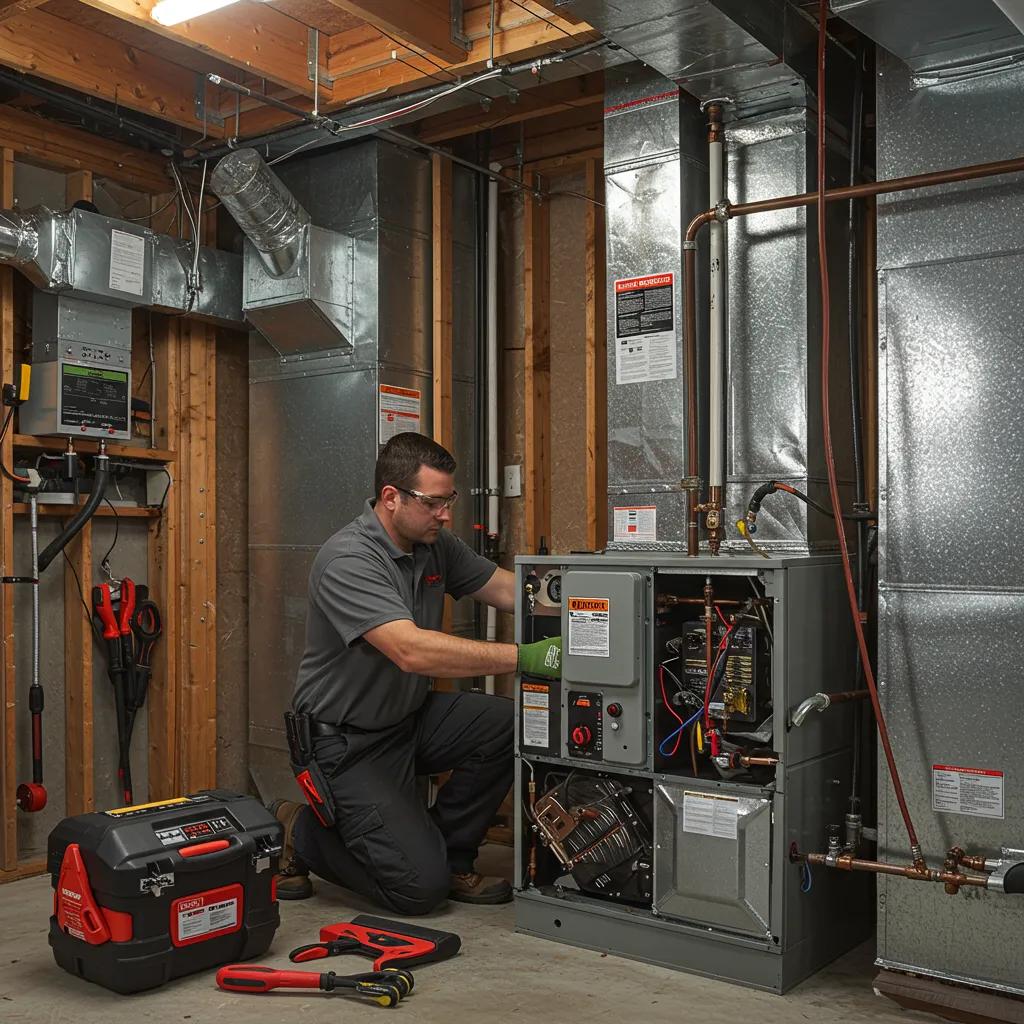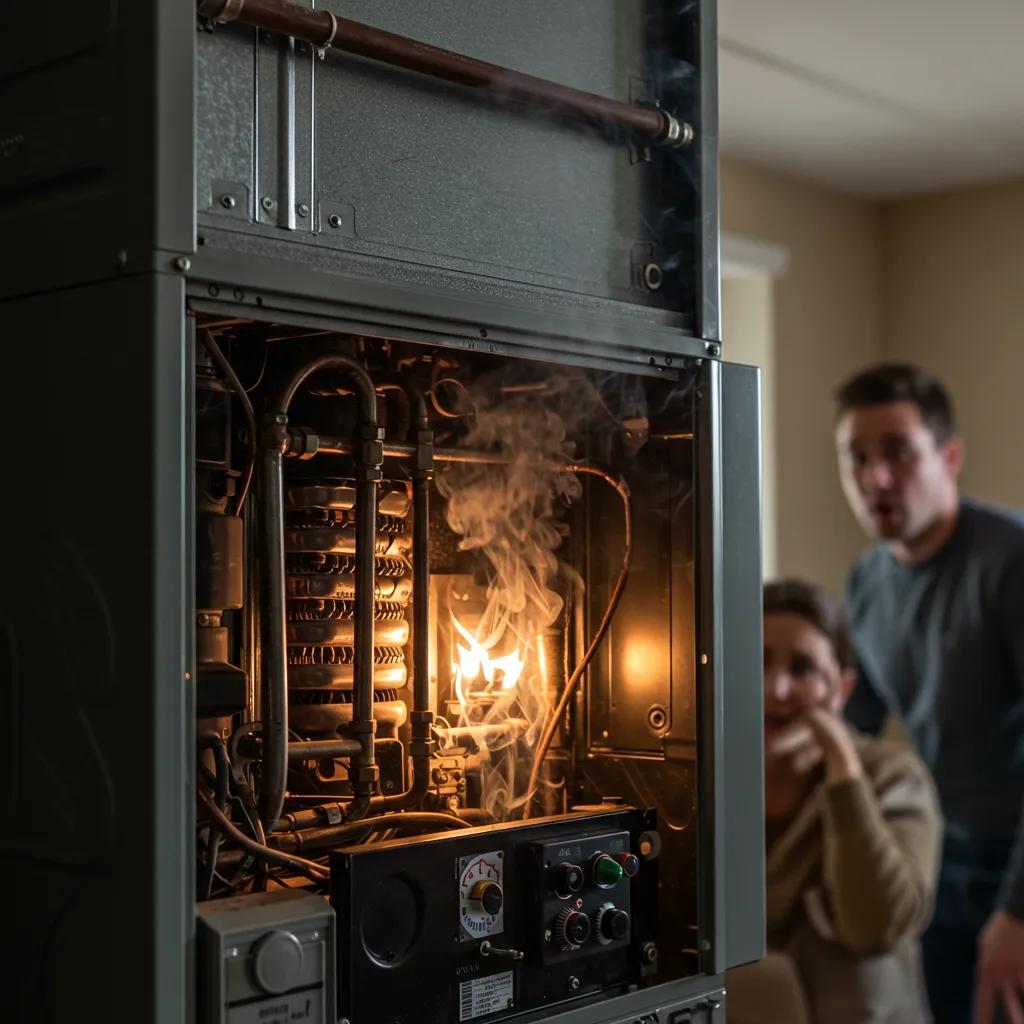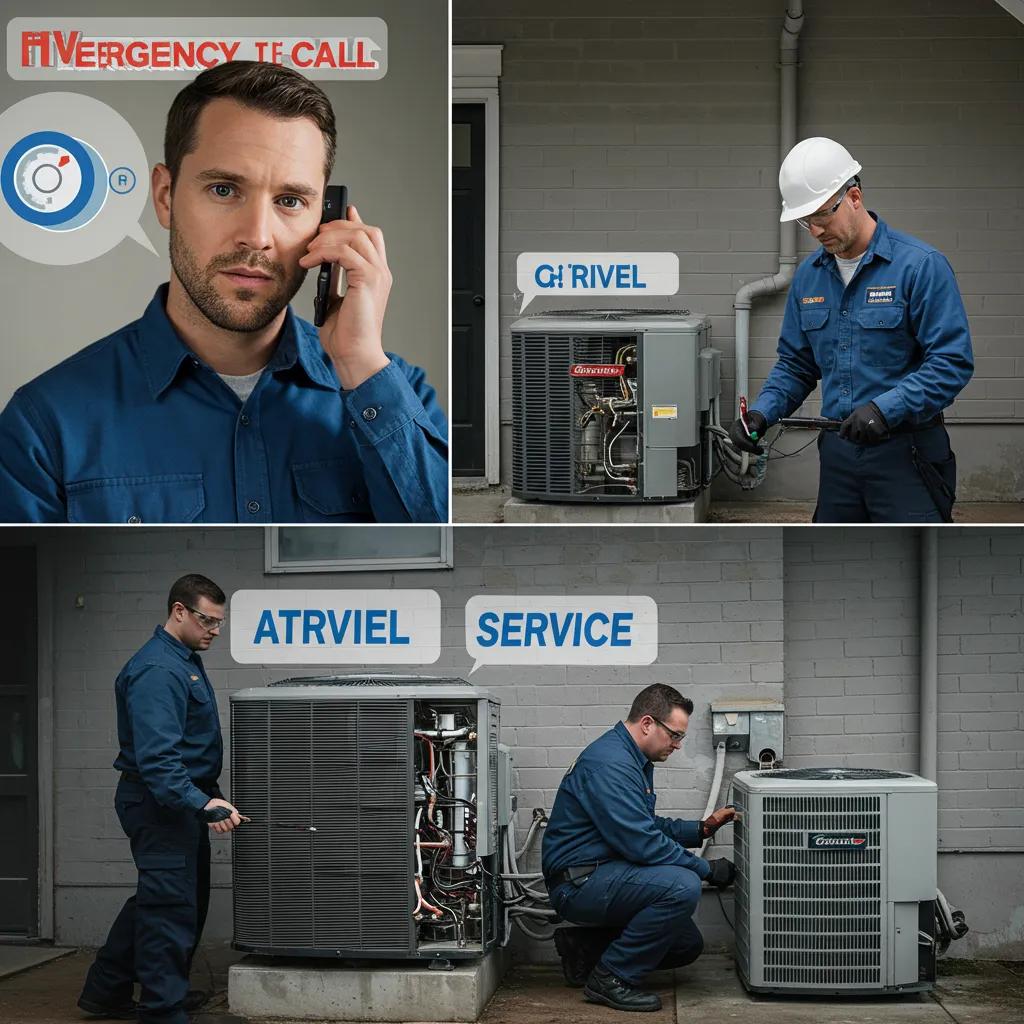
Northwest Indiana HVAC Emergency Repair and 24/7 Service Solutions
When your heating or cooling fails unexpectedly in Northwest Indiana, immediate 24/7 emergency repair restores safety and comfort and prevents property damage. This article explains how homeowners recognize urgent HVAC failures, triage issues safely, and secure fast repairs across Porter and Lake Counties. You will learn the most common emergency scenarios—no heat, no cooling, refrigerant leaks, water and electrical problems—practical homeowner steps to take, and how a rapid response service operates. The guide also covers local coverage in Merrillville, Crown Point, Valparaiso, Portage, Hebron, and Chesterton, transparent emergency cost ranges and financing resources, and preventative maintenance actions that reduce future emergency risk in Northwest Indiana.
What Are the Most Common HVAC Emergencies in Northwest Indiana?
An HVAC emergency is a sudden heating or cooling failure that threatens safety, comfort, or property and requires immediate action to limit harm. These emergencies happen because of component failure, refrigerant loss, electrical faults, or blocked airflow, and resolving them quickly reduces risk to residents and infrastructure. Knowing the most frequent failures helps homeowners triage problems before a technician arrives, saving time and money. The next section lists the top emergency types and immediate homeowner actions to take while awaiting service.
The top HVAC emergencies in Northwest Indiana include the following urgent scenarios and quick homeowner steps:
- No heatduring cold weather: Check thermostat settings and breakers, then call for emergency furnace repair if no power or ignition is present.
- No cooling during heatwaves: Confirm thermostat mode and power, then seek urgent AC service if the home remains hot or occupants are at risk.
- Refrigerant leaks or chemical smells: Shut off the system, ventilate the area, and avoid running the unit to limit exposure and damage.
- Water leaks and condensate overflow: Turn off the air handler power and contain water to prevent structural damage before service arrives.
- Electrical faults and burning smells: Cut power at the breaker and evacuate if you detect burning or smoke, then contact emergency HVAC technicians.
Homeowners can use this quick list to decide when a situation is immediate and when short troubleshooting is safe; the next section provides a concise triage table mapping failures to actions.
Different failures require specific triage to protect people and property before help arrives. The table below maps common failures to immediate homeowner actions so you can act quickly and communicate clear information to a technician.
| Failure Type | Primary Risk | Immediate Homeowner Action |
|---|---|---|
| No Heat | Hypothermia/comfort loss | Check thermostat, reset breakers, document symptoms |
| No Cooling | Heat-related illness | Verify settings, provide cooling spots, call for urgent repair |
| Refrigerant Leak | Health and equipment damage | Turn off system, ventilate, avoid contact |
| Water Leak | Water damage/mold | Power off air handler, contain water, protect belongings |
| Electrical Smell | Fire risk | Cut power, evacuate if needed, call emergency service |
Which Signs Indicate an Emergency Furnace Repair Is Needed?

An emergency furnace repair is indicated when the furnace produces no heat, emits strong odors, cycles endlessly, or shows visible damage, and these symptoms risk safety or abrupt loss of heat. Basic checks include confirming thermostat batteries and settings, resetting tripped breakers, and noting unusual noises or smells to report to technicians. If a pilot is out, there’s yellow combustion, or the system repeatedly fails to ignite, treat it as an emergency and avoid DIY fixes that could be unsafe. Preparing these observations accelerates technician diagnosis and helps determine whether temporary measures or immediate repair are required.
How to Recognize Urgent Air Conditioning Failures in NWI Homes?
Urgent AC failures present as no cooling during hot weather, frozen evaporator coils, strong refrigerant odors, or leaking water that threatens ceilings and floors, and they require fast action to protect health and property. Homeowners should check the outdoor unit for power and remove obstructions, then turn off the system if ice or chemical smells are present to avoid further damage. Documenting temperature differentials and any error codes assists technicians when dispatched for 24/7 service. These initial steps reduce risk and prepare the household for an incoming urgent AC technician.
What Are Typical HVAC System Breakdowns in Valparaiso and Surrounding Areas?
Valparaiso and nearby towns typically see seasonal breakdowns: furnaces fail under cold stress in winter and AC systems overload during summer heat events, often revealing age-related wear or restricted airflow. Local weather swings accelerate component fatigue in older systems and can surface refrigerant or electrical issues that require emergency attention. Early identification through the checks above helps homeowners secure timely service and set realistic expectations for response times in their area. Understanding these seasonal patterns supports better preparedness and quicker recovery when failures occur.
How Does Furnace Exchange LLC Provide Fast and Reliable 24/7 HVAC Emergency Service?

A fast, reliable 24/7 HVAC emergencyservice offers immediate intake, prioritized dispatch, on-site diagnosis, and rapid repair or temporary mitigation to restore safety and comfort. The process prioritizes safety triage, communicates arrival windows, and uses experienced technicians to minimize downtime and prevent repeat failures. Trusted brand access and trained technicians shorten parts lead time and improve first-visit fix rates, which benefits homeowners facing urgent breakdowns. The following subsection outlines the step-by-step service flow you can expect when you call for help.
When you need emergency service, expect this sequence from initial contact through resolution:
- Call intake and triage: Dispatcher documents symptoms, urgency, and safety concerns.
- Rapid dispatch: A technician is assigned and given pre-arrival instructions to prepare the team.
- On-site diagnosis: Technicians assess components, test systems, and identify root causes.
- Repairor mitigation: Immediate repairs or temporary fixes restore function; follow-up recommendations are provided.
What Is the Step-by-Step Process for Emergency HVAC Repair in Northwest Indiana?
Emergency repair begins with a clear intake call describing symptoms, location, and any safety issues so dispatchers can triage and prioritize response appropriately. Dispatch assigns a nearby technician and provides an estimated arrival window while advising on immediate homeowner steps to reduce risk. On-site, the technician performs diagnostics, explains options, and proceeds with approved repairs or temporary measures to restore safe operation. After service, technicians outline next steps and preventive recommendations to lower future emergency risk.
Which Certified Technicians and Trusted Brands Do We Use for Emergency Repairs?
Qualified technicians and reliable brand partnerships reduce repair time and improve outcomes by ensuring correct parts and proven procedures are available during emergencies. Working with authorized brands like York, Guardian, and Bosch facilitates access to compatible parts and technical resources that support faster restoration. Technicians are trained to prioritize safety checks and system diagnostics to limit repeat failures and maintain operational reliability. Clear communication about parts, repair scope, and timing helps homeowners make informed decisions during urgent repairs.
How Do Financing and Discounts Support Emergency HVAC Repairs for NWI Residents?
Financing plans, free estimates, and discount programs help homeowners manage the immediate cost of emergency repairs while securing prompt service to restore safety and comfort. Options that spread costs or apply discounts for eligible groups reduce delays in approving urgent work and make rapid repairs more attainable. When discussing emergency repair options, request a clear estimate and inquire about available financing or discounts to remove financial barriers to prompt action. Contacting service providers with this information ready shortens approval time and speeds the repair process.
(Company note) Furnace Exchange LLC operates as a lead generation and information hub offering comprehensive emergency HVACrepair and maintenanceservices, 24/7 emergency response capability, certified technicians, authorized dealer access for York, Guardian, and Bosch, free estimates, financing options, and exclusive discounts for military and seniors. For immediate assistance call (219) 312-5550 to report your emergency and receive prioritized dispatch.
Fast, Reliable 24/7 HVAC Emergency Service from Furnace Exchange LLC
Emergency furnace and AC services are available across Porter and Lake Counties with local response prioritized by proximity, severity, and current workload to ensure rapid aid for the most urgent failures. Service coverage includes Merrillville, Crown Point, Valparaiso, Portage, Hebron, and Chesterton, and response times vary by town, traffic, and time of day. Knowing which services are available nearby helps homeowners decide when to call for emergency repair versus scheduling next-day service. The table below summarizes coverage and typical response considerations for these locations.
This table clarifies local coverage, common services, and typical response notes so you can judge who to call and what to expect when an HVAC emergency happens.
| Location | Covered Services | Typical Response Time / Notes |
|---|---|---|
| Merrillville | Emergency furnace repair, AC repair, refrigerant response | Prioritized local dispatch, variable by demand |
| Crown Point | 24/7 urgent AC repair, electrical HVAC faults | Fast response in heat events, call for immediate help |
| Valparaiso | Furnace repair, refrigerant and leak repairs | Seasonal demand spikes in winter/summer |
| Portage | Emergency diagnostics and temporary mitigation | Response depends on workload and distance |
| Hebron & Chesterton | Heating and cooling emergency service | Rural routes may affect arrival time |
Use this local mapping to plan emergency action and communicate expected arrival timing when you place a service call; next we outline how to access urgent AC help in specific towns.
What Emergency HVAC Services Are Available in Merrillville and Porter County?
Merrillville and Porter County homeowners can access 24/7 emergency furnace and AC repair, refrigerant leak response, and water-damage mitigation tailored to local seasonal risks. Common emergencies here reflect cold winter furnace failures and summer AC overloads, and dispatch prioritization reflects severity and safety concerns. When contacting emergency service, describe symptoms, any safety hazards, and occupancy status to enable appropriate triage. Ready information speeds dispatch and helps technicians bring needed parts for first-visit repairs.
How to Access 24/7 Urgent AC Repair in Crown Point and Lake County?
To access urgent AC repair in Crown Point and Lake County, provide a clear account of temperature conditions, system behavior, and any safety symptoms during the initial call so dispatch can prioritize your case. In heat events, pre-arrival guidance may include cooling vulnerable occupants and avoiding system operation if burning smells or refrigerant issues are suspected. Expect arrival windows to reflect event demand, and have relevant details ready to shorten diagnosis time. Clear homeowner preparation increases the chance of a fast, effective repair.
What Emergency HVAC Solutions Serve Valparaiso, Hebron, and Chesterton?
Valparaiso, Hebron, and Chesterton receive emergency services for furnace failures, AC breakdowns, refrigerant leaks, and condensate flooding with seasonal priorities that reflect local climate patterns and travel distances. Technicians performing emergency visits balance immediate repairs with temporary mitigation when parts are unavailable, and they will recommend follow-up work to restore full reliability. During winter service calls, prepare thermostat history and recent maintenance records to help the technician. Calling with this context enables faster troubleshooting and safer outcomes.
What Are the Costs and Financing Options for Emergency HVAC Repairs in Northwest Indiana?
Emergency HVACrepair costs vary by type of failure, parts required, labor time, and urgency; typical ranges provide homeowners a baseline to plan immediate decisions. Cost drivers include replacement parts such as control boards or compressors, diagnostic labor, after-hours rates, and any refrigerant or specialty parts needed due to 2025 refrigerant phase-out changes affecting supply and compliance. The following table compares common emergency repair types with typical cost ranges and available financing or discount options to set homeowner expectations.
| Repair Type | Typical Emergency Cost Range | Financing / Discount Options |
|---|---|---|
| Furnace ignition/control issues | $200–$800 | Payment plans, free estimates, senior/military discounts |
| Emergency blower or motor replacement | $300–$1,200 | Short-term financing, discounts for eligible customers |
| Urgent AC compressor failure | $800–$2,500+ | Financing for major replacements, free initial estimate |
| Refrigerant leak repair | $250–$1,000+ | Financing availability; regulatory refrigerant costs may apply |
| Water/condensate overflow mitigation | $150–$600 | Flexible payment options and estimates provided |
This cost table helps homeowners understand likely ranges and the value of asking about financing and discounts when authorizing emergency work.
How Much Does Emergency Furnace Repair Typically Cost in NWI?
Emergency furnace repair costs depend on parts, labor, time of day, and whether temporary measures are required; homeowners often see a range from a few hundred to over a thousand dollars for major components. Factors such as age of the system, availability of parts for authorized brands, and after-hours rates increase cost variability. When deciding between repair and replacement, consider repair price relative to remaining system life and energy efficiency impacts. Requesting a free estimate and an itemized diagnosis helps homeowners make a cost-effective, informed choice.
What Financing Plans Are Available for Urgent HVAC Services?
Financing options for urgent HVACservices commonly include short-term payment plans, deferred-interest programs, and service financing that spreads major repair costs to avoid delaying essential work. Approval and terms vary, so homeowners should ask for specifics when receiving an emergency estimate to understand monthly cost implications. Financing can enable immediate restoration of safe heating or cooling without waiting to accumulate funds. Clear discussion of financing speeds the approval process and reduces repair delays.
Are There Special Discounts for Seniors and Military Personnel?
Discount programs for seniors and military personnel reduce out-of-pocket expense for eligible homeowners and are commonly applied at scheduling or on the estimate to support timely emergency repairs. To claim discounts, have eligibility information ready during the initial intake so dispatchers and technicians can confirm application at service. These discounts help remove financial barriers to prompt repair and improve safety outcomes for vulnerable households. Asking about available programs when you call for emergency service ensures they are applied to your estimate.
(Practical note) For help with costs, free estimates, financing inquiries, and discount verification, contact Furnace Exchange LLC at (219) 312-5550 for assistance and prioritized emergency dispatch.
How Can Homeowners Prevent HVAC Emergencies with 24/7 Maintenance in Northwest Indiana?
Preventative HVACmaintenance identifies wear, adjusts controls, and preserves refrigerant integrity, reducing emergency frequency by catching faults early and ensuring systems run efficiently. Regular maintenance includes filter replacement, airflow checks, refrigerant inspections (especially with 2025 refrigerant changes), electrical tightness tests, and combustion safety evaluations that together lower sudden breakdown risk. A routine, emergency-ready maintenance plan documents system condition and creates priority for rapid response when urgent failures occur. The checklist below offers practical, season-focused maintenance actions homeowners can implement to avoid emergencies.
Preventative steps that reduce emergency risk include the following targeted actions:
- Replace Air Filters Regularly: Maintain airflow and prevent compressor strain by using the correct filter type and replacement schedule.
- Schedule Annual Tune-Ups: Have technicians inspect electrical connections, burners, and refrigerant levels to detect problems early.
- Clear Outdoor Units and DrainLines: Remove debris and ensure condensate drains flow freely to prevent water damage and efficiency losses.
What Are the Benefits of Regular Emergency-Ready HVAC Maintenance?
Regular emergency-ready maintenance improves safety, reduces the frequency of urgent failures, increases energy efficiency, and extends equipment life by detecting issues before they escalate. Documented maintenance also helps prioritize emergency dispatch and provides technicians with a baseline for faster diagnosis during urgent calls. Homeowners who follow scheduled inspections typically experience fewer after-hours breakdowns and lower total repair costs over time. Understanding these benefits underscores why proactive service is a cost-effective strategy for NWI households.
How Does Preventative Service Reduce Sudden HVAC Breakdowns?
Preventative service identifies degraded components like worn belts, low refrigerant, or failing motors before they cause abrupt system failure, and correcting these items during routine visits prevents emergencies. Technicians perform targeted checks—filter, refrigerant, electrical, and safety controls—to reveal hidden faults that lead to breakdowns under stress. Early corrective work is usually less costly and less disruptive than emergency replacement of major components. Maintaining consistent service frequency preserves operational reliability and reduces emergency callouts.
What Emergency Preparedness Tips Should NWI Homeowners Know?
Homeowners should keep a short emergency checklist: know breaker locations, have thermostat and system model information ready, ventilate if refrigerant is suspected, and have contact numbers for 24/7 service to accelerate response. Assemble a simple kit with a flashlight, space heater or fans for short-term comfort, and a log of recent maintenance or error codes to provide to technicians. Recognize clear thresholds for emergency calls: no heat in freezing conditions, AC failure during extreme heat with vulnerable occupants, refrigerant odor, water leaks threatening structure, or electrical burning smells. Preparing this information and supplies streamlines emergency response and reduces emergent risk.